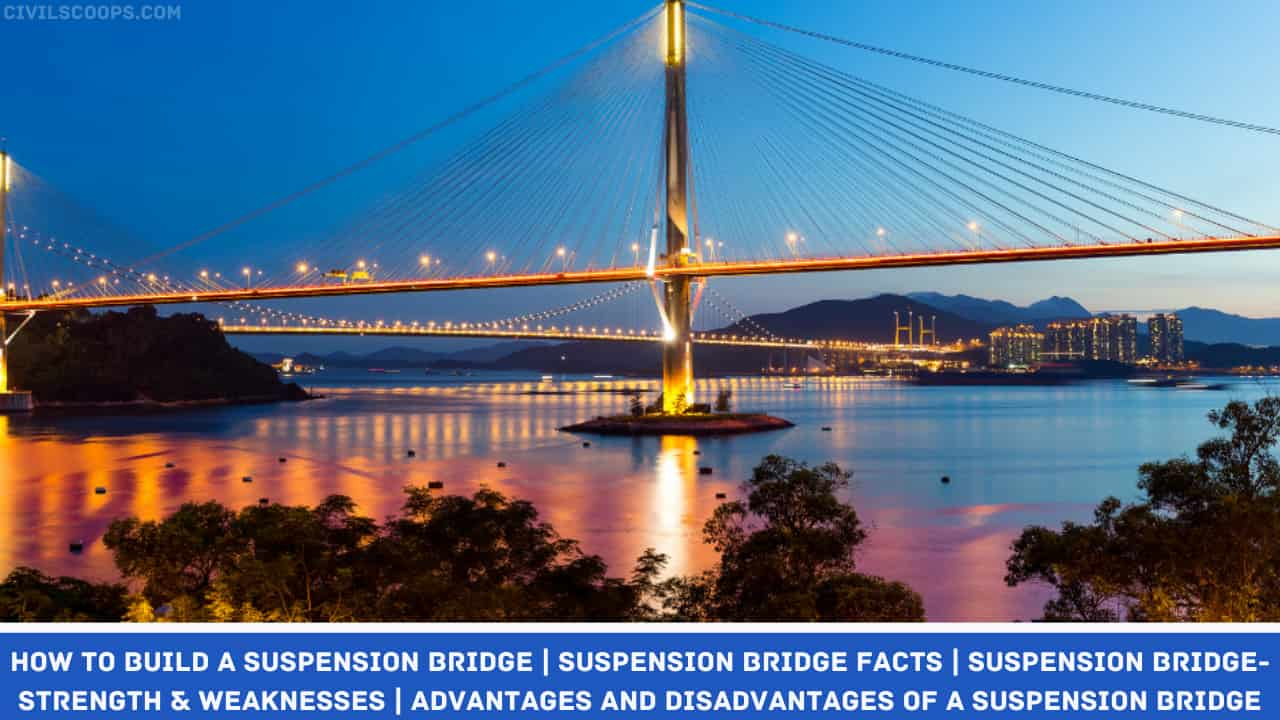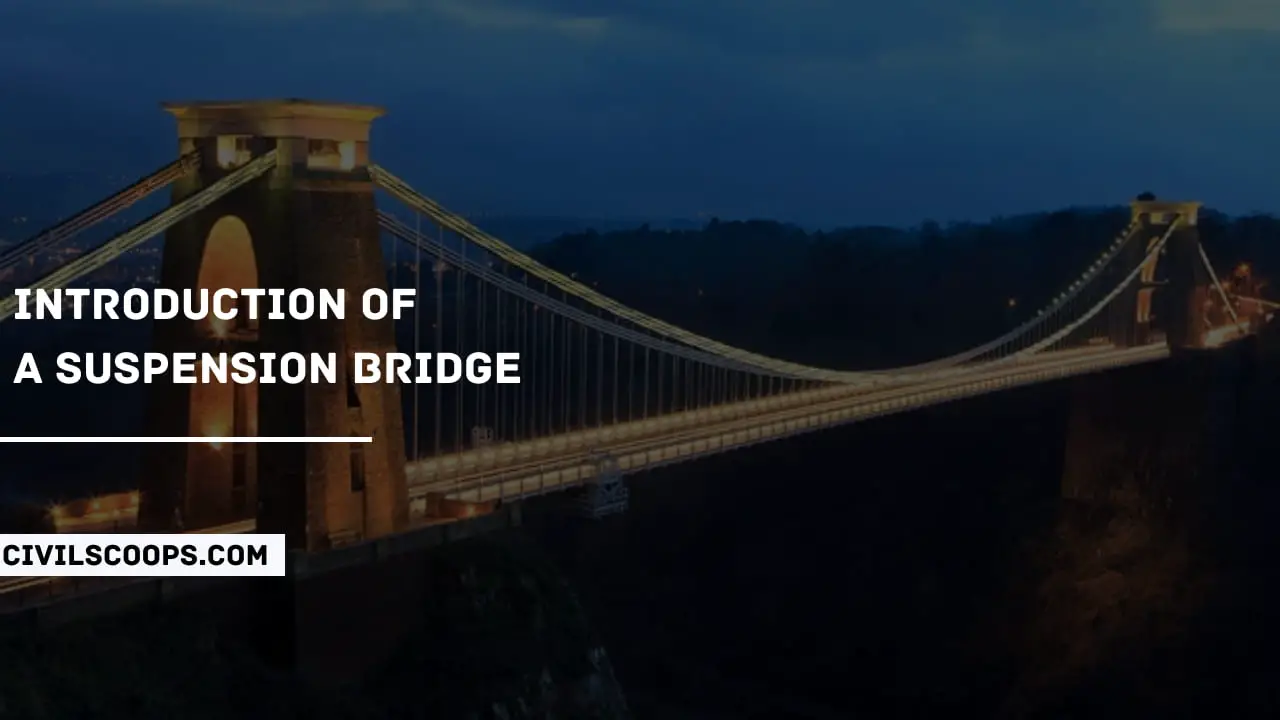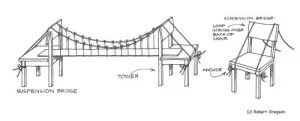How to Build a Suspension Bridge | Suspension Bridge Facts | Suspension Bridge-Strength & Weaknesses | Advantages and Disadvantages of a Suspension Bridge

Table of Contents
Introduction of a Suspension Bridge

Suspension bridges are one of the most popular choices in Bridge construction nowadays, due to the numerous advantages a suspension bridge provides over other bridge structures.
As the name indicates, a suspension bridge is the one in which the bridge deck slab suspends between two towers, or in other words, in a suspension bridge, the deck slab is hanging between two towers of the bridge.
In shape and structural components used in construction, it is very much similar to the cable-stayed bridge structure. The only difference between a cable-stayed and a suspension bridge is that in case of a cable-stayed bridge, only one tower is constructed at the middle of the bridge.
From which the cables support the bridge deck slab, on either side, while in case of a suspension bridge, two towers are constructed from which the cables extents and support the bridge deck slab. The history of suspension bridge goes back go the 15th Century, where rope and woods were the prime materials of construction.
Some of the examples of suspension bridges as famous iconic projects are Golden Gate Bridge, Brooklyn Bridge, Akashi Kaikyo Bridge (Longest suspension bridge till now: spans 6523 feet or 1991 meters, Japan), Humber Bridge (United Kingdom) etc.
How to Build a Suspension Bridge?

The construction procedure of a Suspension bridge is similar to that of ordinary bridge construction, the only exception is in this type of bridge. Cables are required to hold up the bridge deck slab, while ordinary bridge construction does not require it. Before starting on how to build a suspension bridge, it necessary go look at the structural components of a suspension bridge, and for which purpose it is being used for.
The structural components of a suspension bridge include Piers (in the form of large towers), main supporting cables (which are often called “catenary”). Suspenders, and anchorages which are fixed at both ends of the bridge to anchor the main supporting cables.
The initial construction procedure of a suspension bridge involves the construction of the piers or towers following the traditional methods, that is, from foundation to superstructure. In parallel with the construction of towers, the anchor blocks are fixed on both ends of the bridge in order to anchor the main supporting cables.
Once the towers and anchor blocks are in place, the placing of the main cable will take place. The main supporting cables (Catenary), consists of hundreds and thousands of thin wires which are then threaded individually by mechanical equipment, which are placed within two end anchor blocks.
Once all the wires are placed, it is then tied together by wrapping it with steel wires and finally coating it with resin compound, to prevent corrosion. After the main cables are constructed, the suspenders (vertical steel short ropes) are put in place from the main cables. Which generally varies in height and length (smallest in middle span, to the largest in end spans, due to the parabolic shape of main cables).
Then the final phase of the construction starts, which involves placing the bridge deck. The bridge decks are generally placed in segments, each segments being prefabricated. Steel girders/trusses or steel boxes are generally being used for the construction of bridge decks.
The placing of the bridge decks is done incrementally from both the towers towards the middle span, which are progressed simultaneously in order to connect the bridge at the middle span.
After the construction of the main bridge, much smaller approaches at the to the bridge are constructed, which then followed by completion & the delivery of the project, and maintenance after.
How Does a Suspension Bridge Works?

The functions of the different structural components of a suspension bridge are as follows:
1. Suspenders:
- The suspenders overhang from the main supporting cables, which carry the dead and live loads (generally traffic loads) from a bridge and transfer it to the catenary.
2. Main Supporting Cables:
- Parabolic shaped main supporting cables takes the dead & live load of the bridge deck slab from the suspenders and transfers it go the towers/piers.
3. Towers:
- The towers carry the whole load of the bridge deck slab from either side, by taking it from the main supporting cables and transferring it to the foundation, which is further transferred to the subsoil under it.
4. Anchor Blocks:
- The function of the anchor blocks are to fix the main cables at the end of the bridges, at either side of the bridge.
- The suspension bridge works on the principle of transferring tension by converting it onto the compressive forces. The dead and live loads from the bridge decks are first transferred to the suspenders, by tension, which is then transferred into the main supporting cables.
- Which then further transferred into the towers by converting it into compressive forces. The two towers of the suspension bridge carry equal loads in order to stay into equilibrium.
- The weight of the whole suspension bridge is transferred to the towers, which is again transferred to the foundation of the structure and the subsoil below it.
- In a suspension bridge, the main cable tension is concentrated in the anchorages at each end. By contrast, the cable tension in a cable-stayed bridge is distributed over many anchorages along the deck. The more stays the more supports there are to the deck and the lighter and less costly the bridge.
Suspension Bridge Facts
A suspension bridge is a type of bridge in which the deck (the load-bearing portion) is hung below suspension cables on vertical suspenders.
This type of bridge has cables suspended between towers, with vertical suspender cables that transfer the live and dead loads of the deck below, upon which traffic crosses.
Suspension Bridge-Strength & Weaknesses

There are numerous advantages of a suspension bridge which is being preferred nowadays as an effective choice for bridge re-construct as well as new bridges construction. Although not many, suspension bridges do provide some disadvantages.
In contrast, the number of advantages of a suspension bridge far exceeds the disadvantages, which is why suspension bridges are seen as a popular choice of bridge construction.
The Advantages and Disadvantages of a Suspension Bridge includes
Advantages of Suspension Bridges
- Suspension bridges are very affordable to construct as only a minimal amount of materials, and supplies are necessary to construct the bridge. It needs anchor blocks, cables and steel boxes for the bridge deck.
- One of the biggest advantages of a suspension bridge is that it can cover a long span. So it is very suitable for busy waterways and where the length of the waterways are large.
- It is easier to maintain suspension bridges when compared to other bridge structures. Suspension bridge needs little and a nominal amount of maintenance which preferably includes new coats of paints every year. So it is very affordable as it requires one-time large investment behind the construction of the structure.
- There is more flexibility in the configuration of the suspension bridges. As the suspension bridges are constructed into different segments which are then joined to form the bridge, it is very much possible to modify any part of the structure for maintenance or other structural reasons.
- This type of bridge design requires very little access from the bottom of the deck. As the design of a suspension bridge requires the design of cables and suspenders, there is no necessity to access the bottom of the deck, which again proves to be economical for a technical audit of the structure.
- Suspension bridges can be visually appealing from the aesthetic viewpoint. The parabolic shape of the cable and the shape of the structure provides an aesthetically pleasing experience, which results in increased tourism, affecting the economy of the country as a whole.
Disadvantages of Suspension Bridges
- Suspension bridges can struggle to focus on heavy loads. As this type of bridge can be used to cover very large spans, it’s the inability to carry concentrated focused loads may become a major drawback for the high traffic cities and countries.
- Suspension bridges are weak against high wind. Due to the lower stiffness of the bridge, high winds and earthquakes can cause major damages to the bridge resulting in vibration, and ultimately, failure of the bridge.
- A little amount of access from the bottom deck may be necessary during the construction of a suspension bridge, which can be avoided in cable cable-stayed.
- A suspension bridge has lower feck stiffness compared to other bridge structures.
There are many other pros and cons of a suspension bridge, within which the included ones may be considered important.
Suspension Bridge Pros and Cons
[su_table responsive=”yes”]
| Pros of Suspension Bridge | Cons of Suspension Bridges |
|
|
[/su_table]
[su_box title=”FAQ” style=”default” box_color=”#333333″ title_color=”#FFFFFF” radius=”3″ class=”” id=””]
How Are Suspension Bridges Constructed?
A suspension bridge is a type of bridge in which the deck is hung below suspension cables on vertical suspenders. The basic structural components of a suspension bridge system include stiffening girders/trusses, the main suspension cables, main towers, and the anchorages for the cables at each end of the bridge.
What Is the Construction Material of a Suspension Bridge?
The towers of most suspension bridges are made of steel, although a few have been built of steel-reinforced concrete.
Suspension Bridge Disadvantages
- Suspension bridges can struggle to support focused heavy weights.
- There is less flexibility with a suspension bridge.
- High winds can cause a suspension bridge to start vibrating.
- Some access below the deck may be necessary during construction.
Suspension Bridge
A suspension bridge is a type of bridge in which the deck is hung below suspension cables on vertical suspenders. The first modern examples of this type of bridge were built in the early 1800s. Simple suspension bridges, which lack vertical suspenders, have a long history in many mountainous parts of the world.
Capilano Suspension Bridge Park
The Capilano Suspension Bridge is a simple suspension bridge crossing the Capilano River in the District of North Vancouver, British Columbia, Canada. The current bridge is 140 metres long and 70 metres above the river.
Suspension Bridge Examples
[su_table responsive=”yes”]
|
Rank |
Name | Year Opened |
| 1 | Akashi Kaikyō Bridge | 1998 |
| 2 | Xihoumen Bridge | 2009 |
| 3 | Great Belt Bridge | 1998 |
| 4 | Yi Sun-sin Bridge | 2012 |
| 5 | Runyang Bridge | 2005 |
| 6 | Nanjing Fourth Yangtze Bridge | 2012 |
| 7 | Humber Bridge | 1981 |
| 8 | Jiangyin Bridge | 1999 |
| 9 | Tsing Ma Bridge | 1997 |
| 10 | Hardanger Bridge | 2013 |
[/su_table]
How Does a Suspension Bridge Works?
A suspension bridge carries vertical loads through curved cables in tension. These loads are transferred both to the towers, which carry them by vertical compression to the ground, and to the anchorages, which must resist the inward and sometimes vertical pull of the cables.
What Is a Suspension Bridge Used For?
Suspension bridges (fig. 1) are used to carry light loads over long spans where swift or deep streams, deep ravines, and difficult approach roads or trails make imprac- ticable the use of standard bridging equipage.
Suspension Bridge Facts
Suspension bridge is a type of bridge which has cables between towers (so called “suspension cables”) and from them vertical “suspender cables” (or hangers”) that hold the deck. Suspension cables are anchored at each end of the bridge and they carry the majority of the load.
[/su_box]
[su_note note_color=”#F2F2F2 ” text_color=”#333333″ radius=”3″ class=”” id=””]
Like this post? Share it with your friends!
Suggested Read –
- Difference Between Short Column and Long Column
- What Is Estimate? | Types of Estimate | Advantage of Estimate | Disadvantage of Estimate
- What Is Tie Beam? | Tie Beam Details | Ties in Column | Tie Beam Design | Concrete Tie Beam | Tie Beam Reinforcement Details
- What Is Development Length | Why We Provide Development Length | How to Calculate Development Length | Development Length for Single Bars
- What Is Epoxy? | What Is Epoxy Flooring? | Types of Epoxy Flooring | Advantages of Epoxy Flooring | Disadvantages of Epoxy Flooring | Uses of Epoxy Flooring | Application Process of Epoxy Flooring
[/su_note]
Originally posted 2022-07-15 15:30:43.
